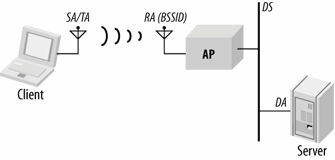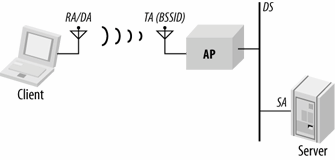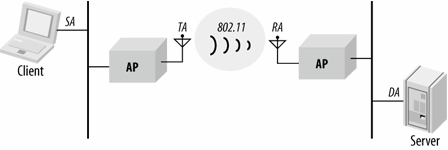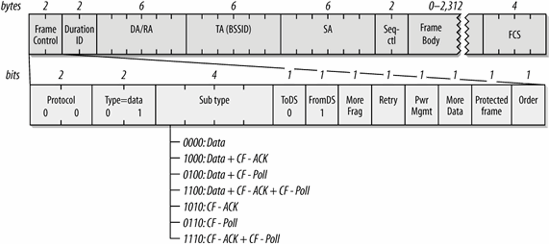Data Frames
Data frames carry higher-level protocol data in the frame body. Figure 4-1 shows a generic data frame. Depending on the particular type of data frame, some of the fields in the figure may not be used.
Figure 4-1. Generic data frame

The different data frame types can be categorized according to function. One such distinction is between data frames used for contention-based service and those used for contention-free service. Any frames that appear only in the contention-free period can never be used in an IBSS. Another possible division is between frames that carry data and frames that perform management functions. Table 4-1 shows how frames may be divided along these lines. Frames used in contention-free service are discussed in detail in Chapter 9.
|
Frame type |
Contention-based service |
Contention-free service |
Carries data |
Does not carry data |
||||||||||||||
|---|---|---|---|---|---|---|---|---|---|---|---|---|---|---|---|---|---|---|
|
Data |
|
|
Data+CF-Ack |
|
|
Data+CF-Poll |
AP only |
|
Data+CF-Ack+CF-Poll |
AP only |
|
Null |
|
|
|
|||
|
CF-Ack |
|
|
||||||||||||||||
|
CF-Poll |
AP only |
|
||||||||||||||||
|
CF-Ack+CF-Poll |
AP only |
|
Frame Control
All the bits in the Frame Control field are used according to the rules described in Chapter 3. Frame Control bits may affect the interpretation of other fields in the MAC header, though. Most notable are the address fields, which depend on the value of the ToDS and FromDS bits.
Duration
The Duration field carries the value of the Network Allocation Vector (NAV). Access to the medium is restricted for the time specified by the NAV. Four rules specify the setting for the Duration field in data frames:
- Any frames transmitted during the contention-free period set the Duration field to 32,768. Naturally, this applies to any data frames transmitted during this period.
- Frames transmitted to a broadcast or multicast destination (Address 1 has the group bit set) have a duration of 0. Such frames are not part of an atomic exchange and are not acknowledged by receivers, so contention-based access to the medium can begin after the conclusion of a broadcast or multicast data frame. The NAV is used to protect access to the transmission medium for a frame exchange sequence. With no link-layer acknowledgment following the transmission of a broadcast or multicast frame, there is no need to lock access to the medium for subsequent frames.
- If the More Fragments bit in the Frame Control field is 0, no more fragments remain in the frame. The final fragment need only reserve the medium for its own ACK, at which point contention-based access resumes. The Duration field is set to the amount of time required for one short interframe space and the fragment acknowledgment. Figure 4-2 illustrates this process. The penultimate fragment's Duration field locks access to the medium for the transmission of the last fragment.
Figure 4-2. Duration setting on final fragment

- If the More Fragments bit in the Frame Control field is set to 1, more fragments remain. The Duration field is set to the amount of time required for transmission of two acknowledgments, plus three short interframe spaces, plus the time required for the next fragment. In essence, nonfinal fragments set the NAV just like an RTS would (Figure 4-3); for this reason, they are referred to as a virtual RTS.
Figure 4-3. Duration settings on nonfinal fragment

Addressing and DS Bits
The number and function of the address fields depends on which of the distribution system bits are set, so the use of the address fields indirectly depends on the type of network deployed. Table 4-2 summarizes the use of the address fields in data frames. The fourth address field is only used by wireless bridges, and is therefore relatively uncommon.
|
Function |
ToDS |
FromDS |
Address 1 (receiver) |
Address 2 (transmitter) |
Address 3 |
Address 4 |
|---|---|---|---|---|---|---|
|
IBSS |
0 |
0 |
DA |
SA |
BSSID |
Not used |
|
To AP (infra.) |
1 |
0 |
BSSID |
SA |
DA |
Not used |
|
From AP (infra.) |
0 |
1 |
DA |
BSSID |
SA |
Not used |
|
WDS (bridge) |
1 |
1 |
RA |
TA |
DA |
SA |
Address 1 indicates the receiver of the frame. In many cases, the receiver is the destination, but not always. The destination is the station that will process the network-layer packet contained in the frame; the receiver is the station that will attempt to decode the radio waves into an 802.11 frame. If Address 1 is set to a broadcast or multicast address, the BSSID is also checked. Stations respond only to broadcasts and multicasts originating in the same basic service set (BSS); they ignore broadcasts and multicasts from different BSSIDs.[*] Address 2 is the transmitter address and is used to send acknowledgments. Transmitters are not necessarily senders. The sender is the frame that generated the network-layer protocol packet in the frame; the transmitter put the frame on to the radio link. The Address 3 field is used for filtering by access points and the distribution system, but the use of the field depends on the particular type of network used.
[*] Not all cards perform this BSSID filtering correctly. Many products will pass all broadcasts up to higher protocol layers without validating the BSSID first.
In the case of an IBSS, no access points are used, and no distribution system is present. The transmitter is the source, and the receiver is the destination. All frames carry the BSSID so that stations may check broadcasts and multicasts; only stations that belong to the same BSS will process broadcasts and multicasts. In an IBSS, the BSSID is created by a random-number generator.
802.11 draws a distinction between the source and transmitter and a parallel distinction between the destination and the receiver. The transmitter sends a frame on to the wireless medium but does not necessarily create the frame. A similar distinction holds for destination addresses and receiver addresses. A receiver may be an intermediate destination, but frames are processed by higher protocol levels only when they reach the destination.
To expand on these distinctions, consider the use of the address fields in infrastructure networks. Figure 4-4 shows a simple network in which a wireless client is connected to a server through an 802.11 network. Frames sent by the client to the server use the address fields as specified in the second line of Table 4-2.
Figure 4-4. Address field usage in frames to the distribution system

In the case of frames bound for a destination on the distribution system, the client is both source and transmitter. The receiver of the wireless frame is the access point, but the access point is only an intermediate destination. When the frame reaches the access point, it is relayed to the distribution system to reach the server. Thus, the access point is the receiver, and the (ultimate) destination is the server. In infrastructure networks, access points create associated BSSs with the address of their wireless interfaces, which is why the receiver address (Address 1) is set to the BSSID.
When the server replies to the client, frames are transmitted to the client through the access point, as in Figure 4-5. This scenario corresponds to the third line in Table 4-2.
Figure 4-5. Address field usage in frames from the distribution system

Frames are created by the server, so the server's MAC address is the source address for frames. When frames are relayed through the access point, the access point uses its wireless interface as the transmitter address. As in the previous case, the access point's interface address is also the BSSID. Frames are ultimately sent to the client, which is both the destination and receiver.
The fourth line in Table 4-2 shows the use of the address fields in a wireless distribution system (WDS), which is sometimes called a wireless bridge. In Figure 4-6, two wired networks are joined by access points acting as wireless bridges. Frames bound from the client to the server traverse the 802.11 WDS. The source and destination addresses of the wireless frames remain the client and server addresses. These frames, however, also identify the transmitter and receiver of the frame on the wireless medium. For frames bound from the client to the server, the transmitter is the client-side access point, and the receiver is the server-side access point. Separating the source from the transmitter allows the server-side access point to send required 802.11 acknowledgments to its peer access point without interfering with the wired link layer.
Figure 4-6. Wireless distribution system

Variations on the Data Frame Theme
802.11 uses several different data frame types. Variations depend on whether the service is contention-based or contention-free. Contention-free frames can incorporate several functions for the sake of efficiency. Data may be transmitted, but by changing the frame subtype, data frames in the contention-free period may be used to acknowledge other frames, saving the overhead of interframe spaces and separate acknowledgments. Here are the different data frame types that are commonly used:
Data
Frames of the Data subtype are transmitted only during the contention-based access periods. They are simple frames with the sole purpose of moving the frame body from one station to another.
Null
Null frames[*] are a bit of an oddity. They consist of a MAC header followed by the FCS trailer. In a traditional Ethernet, empty frames would be extraneous overhead; in 802. 11 networks, they are used by mobile stations to inform the access point of changes in power-saving status. When stations sleep, the access point must begin buffering frames for the sleeping station. If the mobile station has no data to send through the distribution system, it can use a Null frame with the Power Management bit in the Frame Control field set. Access points never enter power-saving mode and do not transmit Null frames. Usage of Null frames is shown in Figure 4-7.
[*] To indicate that Null is used as the frame type from the specification rather than the English word, it is capitalized. This convention will be followed throughout the chapter.
Figure 4-7. Data frame of subtype Null

Several other frame types exist for use within the contention-free period. However, contention-free service is not widely implemented; the discussion of the contention-free frames (Data+CF-Ack, Data+CF-Poll, Data+CF-Ack+CF-Poll, CF-Ack, CF-Poll, and CF-Ack+CF-Poll) can be found in Chapter 9.
Applied Data Framing
The form of a data frame can depend on the type of network. The actual subtype of the frame is determined solely by the subtype field, not by the presence or absence of other fields in the frame.
IBSS frames
In an IBSS, three address fields are used, as shown in Figure 4-8. The first address identifies the receiver, which is also the destination address in an IBSS. The second address is the source address. After the source and destination addresses, data frames in an IBSS are labeled with the BSSID. When the wireless MAC receives a frame, it checks the BSSID and passes only frames in the station's current BSSID to higher protocol layers.
Figure 4-8. IBSS data frame

IBSS data frames have the subtype data or Null; the latter is used only to communicate power management state.
Frames from the AP
Figure 4-9 shows the format of a frame sent from an access point to a mobile station. As in all data frames, the first address field indicates the receiver of the frame on the wireless network, which is the frame's destination. The second address holds the transmitter address. On infrastructure networks, the transmitter address is the address of the station in the access point, which is also the BSSID. Finally, the frame indicates the source MAC address of the frame. The split between source and transmitter is necessary because the 802.11 MAC sends acknowledgments to the frame's transmitter (the access point), but higher layers send replies to the frame's source.
Figure 4-9. Data frames from the AP

Nothing in the 802.11 specification forbids an access point from transmitting Null frames, but there is no reason to transmit them. Access points are forbidden from using the power-saving routines, and they can acknowledge Null frames from stations without using Null frames in response. In practice, access points send Data frames during the contention-based access period, and they send frames incorporating the CF-Poll feature during the contention-free period.
Frames to the AP
Figure 4-10 shows the format of a frame sent from a mobile station in an infrastructure network to the access point currently serving it. The receiver address is the BSSID. In infrastructure networks, the BSSID is taken from the MAC address of the network station in the access point. Frames destined for an access point take their source/transmitter address from the network interface in the wireless station. Access points do not perform filtering, but instead use the third address to forward data to the appropriate location in the distribution system.
Frames from the distribution system have the ToDS bit set, but the FromDS bit is 0. Mobile stations in an infrastructure network cannot become the point coordinator, and thus never send frames that incorporate the contention-free polling (CF-Poll) functions.
Frames in a WDS
When access points are deployed in a wireless bridge (or WDS) topology, all four address fields are used, as shown in Figure 4-11. Like all other data frames, WDS frames use the first address for the receiver of the frame and the second address for the transmitter. The MAC uses these two addresses for acknowledgments and control traffic, such as RTS, CTS, and ACK frames. Two more address fields are necessary to indicate the source and destination of the frame and distinguish them from the addresses used on the wireless link.
Figure 4-10. Data frames to the AP

Figure 4-11. WDS frames

On a wireless bridging link, there are no mobile stations, and the contention-free period is not used. Access points are forbidden to enter power-saving modes, so the power management bit is always set to 0.
Encrypted frames
Frames protected by link layer security protocols are not new frame types. When a frame is handled by encryption, the Protected Frame bit in the Frame Control field is set to 1, and the Frame Body field begins with the appropriate cryptographic header described in Chapters 5 or Chapter 7, depending on the protocol.
Introduction to Wireless Networking
- Introduction to Wireless Networking
- Why Wireless?
- What Makes Wireless Networks Different
- A Network by Any Other Name...
Overview of 802.11 Networks
- Overview of 802.11 Networks
- IEEE 802 Network Technology Family Tree
- 11 Nomenclature and Design
- 11 Network Operations
- Mobility Support
11 MAC Fundamentals
- 11 MAC Fundamentals
- Challenges for the MAC
- MAC Access Modes and Timing
- Contention-Based Access Using the DCF
- Fragmentation and Reassembly
- Frame Format
- Encapsulation of Higher-Layer Protocols Within 802.11
- Contention-Based Data Service
- Frame Processing and Bridging
11 Framing in Detail
- 11 Framing in Detail
- Data Frames
- Control Frames
- Management Frames
- Frame Transmission and Association and Authentication States
Wired Equivalent Privacy (WEP)
- Wired Equivalent Privacy (WEP)
- Cryptographic Background to WEP
- WEP Cryptographic Operations
- Problems with WEP
- Dynamic WEP
User Authentication with 802.1X
- User Authentication with 802.1X
- The Extensible Authentication Protocol
- EAP Methods
- 1X: Network Port Authentication
- 1X on Wireless LANs
11i: Robust Security Networks, TKIP, and CCMP
- 11i: Robust Security Networks, TKIP, and CCMP
- The Temporal Key Integrity Protocol (TKIP)
- Counter Mode with CBC-MAC (CCMP)
- Robust Security Network (RSN) Operations
Management Operations
- Management Operations
- Management Architecture
- Scanning
- Authentication
- Preauthentication
- Association
- Power Conservation
- Timer Synchronization
- Spectrum Management
Contention-Free Service with the PCF
- Contention-Free Service with the PCF
- Contention-Free Access Using the PCF
- Detailed PCF Framing
- Power Management and the PCF
Physical Layer Overview
- Physical Layer Overview
- Physical-Layer Architecture
- The Radio Link
- RF Propagation with 802.11
- RF Engineering for 802.11
The Frequency-Hopping (FH) PHY
- The Frequency-Hopping (FH) PHY
- Frequency-Hopping Transmission
- Gaussian Frequency Shift Keying (GFSK)
- FH PHY Convergence Procedure (PLCP)
- Frequency-Hopping PMD Sublayer
- Characteristics of the FH PHY
The Direct Sequence PHYs: DSSS and HR/DSSS (802.11b)
- The Direct Sequence PHYs: DSSS and HR/DSSS (802.11b)
- Direct Sequence Transmission
- Differential Phase Shift Keying (DPSK)
- The Original Direct Sequence PHY
- Complementary Code Keying
- High Rate Direct Sequence PHY
11a and 802.11j: 5-GHz OFDM PHY
- 11a and 802.11j: 5-GHz OFDM PHY
- Orthogonal Frequency Division Multiplexing (OFDM)
- OFDM as Applied by 802.11a
- OFDM PLCP
- OFDM PMD
- Characteristics of the OFDM PHY
11g: The Extended-Rate PHY (ERP)
- 11g: The Extended-Rate PHY (ERP)
- 11g Components
- ERP Physical Layer Convergence (PLCP)
- ERP Physical Medium Dependent (PMD) Layer
A Peek Ahead at 802.11n: MIMO-OFDM
11 Hardware
- 11 Hardware
- General Structure of an 802.11 Interface
- Implementation-Specific Behavior
- Reading the Specification Sheet
Using 802.11 on Windows
11 on the Macintosh
Using 802.11 on Linux
- Using 802.11 on Linux
- PCMCIA Support on Linux
- Linux Wireless Extensions and Tools
- Agere (Lucent) Orinoco
- Atheros-Based cards and MADwifi
- 1X on Linux with xsupplicant
Using 802.11 Access Points
- Using 802.11 Access Points
- General Functions of an Access Point
- Power over Ethernet (PoE)
- Selecting Access Points
- Cisco 1200 Access Point
- Apple AirPort
Logical Wireless Network Architecture
- Logical Wireless Network Architecture
- Evaluating a Logical Architecture
- Topology Examples
- Choosing Your Logical Architecture
Security Architecture
- Security Architecture
- Security Definition and Analysis
- Authentication and Access Control
- Ensuring Secrecy Through Encryption
- Selecting Security Protocols
- Rogue Access Points
Site Planning and Project Management
- Site Planning and Project Management
- Project Planning and Requirements
- Network Requirements
- Physical Layer Selection and Design
- Planning Access-Point Placement
- Using Antennas to Tailor Coverage
11 Network Analysis
11 Performance Tuning
Conclusions and Predictions
EAN: 2147483647
Pages: 179

